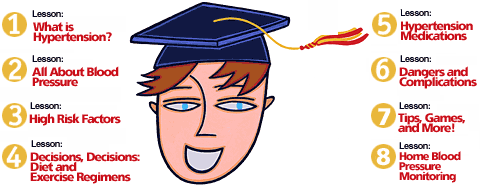


Back to Hypertension Channel
120/80 mm Hg...What does that MEAN?
Your body works like an incredible machine. You give it fuel, and it keeps your insides running up to speed, 24 hours a day, seven days a week, for year upon year...without any breaks! I bet you'd be hard pressed to think of another machine with that kind of track record.
Blood pressure is an essential element of this machine. Everybody has it, and everybody needs it. Without blood pressure, your blood can't circulate throughout the body. Without circulating blood, vital organs and your body's extremities can't get the nutrients and oxygen they need to remain working and healthy. Without healthy working organs, well...you know what that means.
Each time your heart beats (usually between 60 to 100 times per minute), blood is pumped through the arteries in your body. This creates pressure — blood pressure — within these blood vessels. Your blood pressure rises and falls as your heart beats and then relaxes. Hence, there are two different forces acting on your arteries and other blood vessels that combine to form your blood pressure reading.
Systolic pressure
The first number in your blood pressure reading is called the systolic pressure. This is the force created as your heart contracts to pump blood through your arteries. It is at this point, when your heart is in the middle of a beat, or fully contracting, that your blood exerts its maximum pressure against the arterial wall.
Diastolic pressure
The second number that goes into your blood pressure reading is called the diastolic pressure. This is the force created by your blood against the arterial wall when your heart is in between beats, or, as it "relaxes".
The diastolic pressure is always smaller than the systolic pressure, which makes a great deal of sense if you think of it in terms of the heart "pushing" the blood through your arteries, and the arteries "stretching" to let the blood pass through them. When the heart is resting, it does not "push" the blood, so the blood is just moving on its natural course of momentum and gravity. This in turn creates a lower pressure, and a lower number.
Both numbers count!
Contrary to previous thought, recent studies show that the systolic and diastolic pressures are equally important in determining your cardiovascular health.
Copyright © 2000-2025 savvyHEALTH.com. All rights reserved.
http://www.savvyHEALTH.com/
All contents copyright © 1999-2025 savvyHEALTH, Inc. All rights reserved.
This internet site provides information of a general nature and is
designed for educational purposes only. If you have any concerns about
your own health, you should always consult
with a physician or other healthcare professional. Please review the Terms of Use before using this site. Your use of the site indicates your agreement to be bound by the Terms of Use.